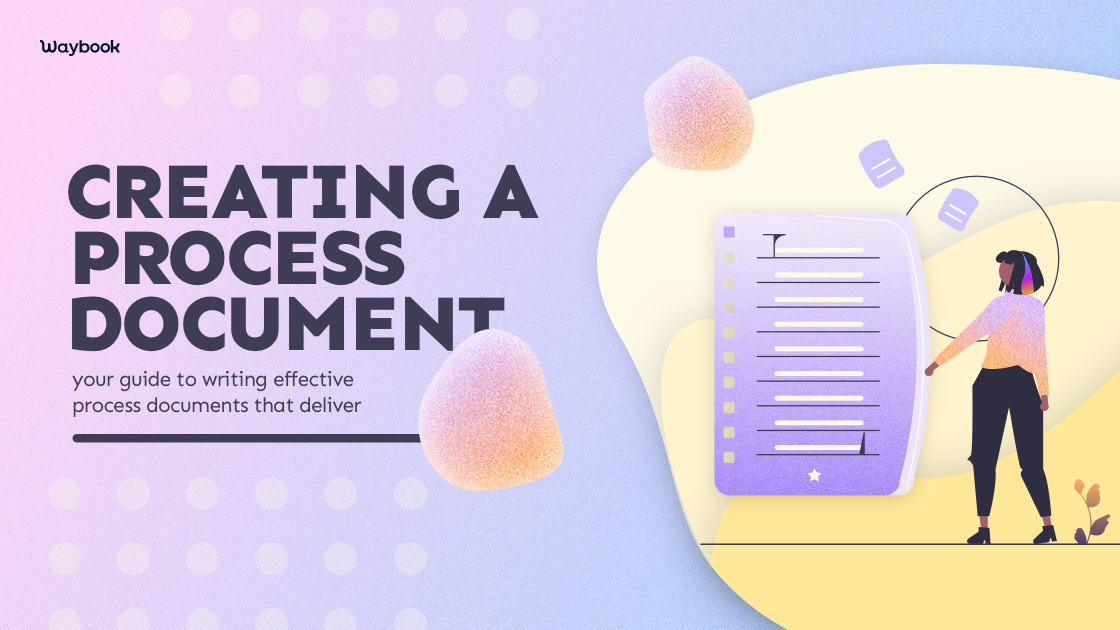A system to track how your business functions is essential for efficiency, consistency, and transparency. Things will surely become more complicated as your company grows. There are more people, tasks, and steps to organize, all of which must be done in the most efficient manner.
Many startups and businesses lose momentum as soon as they increase their personnel, assuming that things would automatically fall into place and procedures will work themselves out.
To overcome all these issues, creating business process documentation is crucial. Creating an effective process document makes it easier for new employees to learn their tasks and for the current employees to optimize their work.
In this read, we'll get you through the whole step-by-step of process documentation, including:
- Importance of Learning How to Write a Process Document
- Benefits of Writing a Process Document
- Cost Effective
- Assistance in Mitigating Risks
- Learning Space for Workers
- Effective Outsourcing Process
- Step by Step Guide on How to write a Process Document
- Selecting the Process
- Defining Process Boundaries & Scope
- Describing Process Inputs and Outcomes
- Building Process Sequence
- Describe Who’s Involved
- Mapping Process Workflow
- Defining Exceptions and Identifying Control Points
- Review and Evaluate the Process
Importance of Learning How to Write a Process Document
A process document is a step-by-step explanation of how a task or procedure is carried out. It can also be defined as explaining how a work project or procedure is done or as a manual of carrying out a particular task. Creating business process documentation is a great way to help companies be more efficient and ensure every employee completes their duties in the same manner.
Following process documentation best practices help you to communicate your message with clarity and precision. The process involves brainstorming, researching, outlining, drafting, and revising. Writing the process to the end allows you to present an organized piece of clear and concise work.

Benefits of Writing a Process Document
1.Cost-Effective
The benefits of process documentation can be explicitly observed in the long run. Rather than spending time and energy to train every worker, processing documents will help get new employees up to speed. Over time, this can translate into greater productivity and, thus, higher profits.
2. Consistent Output
A properly crafted and readily available process document helps employees reference certain things immediately. This allows them to get better with the specified tasks instead of waiting for updates from other team members. In addition, predefined rules and regulations ease the execution of any project. Process documentation saves your team from a lot of hassle, guaranteeing a consistent output without delays.
3. Assistance in Mitigating Risks
Risk mitigation is one of a project manager's primary responsibilities. A process document helps with this by identifying risks and establishing contingencies.
When project managers produce process documents, they must identify all the associated risks and establish contingencies to mitigate those risks. For example, a common project risk is an employee leaving the company during a project's key stages. A contingency for this may be creating a second backup team that can step in if needed.
4. Learning Space for Workers
Most workers are eager to learn. Process documentation best practices can provide the required space by offering opportunities for workers to demonstrate their understanding of the processes. Additionally, it also offers assistance in expanding employees' knowledge base through trial and error. However, this is only possible if these documents are written in an easy-to-understand format.
5. Effective Outsourcing Process
Process documentation enables you to outsource specific parts of your business processes as needed. It also gives you a better idea about which tasks need outsourcing. So, you can send out work faster to subject matter experts for efficient execution.
6. Faster Business Upscale
Process document is a perfect remedy to preserve organizational knowledge. It creates a sort of textbook for future upgrades and training. Without this, your business will need to redo the whole process from scratch, which is neither cost-effective nor feasible in most cases. Process document helps companies smoothly transfer standards and requirements to the teams instead of training everyone regularly.
In addition, for any merger or acquisition, you can quickly jump start from the already compiled document. All these approaches assist your business to upscale at a much higher pace.
Step by Step Guide on How to write a Process Document

1. Selecting the Process
Before you start writing, it's a good idea to select the process to be documented. You can choose a process that is:
- Important: The process has a significant impact on the organization.
- Unclear or Complex: The process involves multiple people or departments and requires complex decision-making.
- Frequently executed: The process needs to be executed many times, so documenting will save time for everyone involved.
2. Defining Process Boundaries & Scope
Once you've selected the process, define its boundaries and scope by answering the following questions:
- What is the beginning point of the process? When does it start?
- What is the endpoint of the process? When does it finish?
- Who are all of the people involved in performing these activities? What role(s) are they playing?
- What tools, technologies, or software applications?
- What outcomes are desired?
3. Describing Process Inputs and Outcomes
Process documentation describes the sequence of events and steps necessary to perform a task or a process. The purpose of process documentation is to provide information about doing the required activity. The first step of creating process documentation is identifying the inputs and outcomes.
- Inputs represent the resources or requirements before the process begins.
- Outputs represent what is produced due to the process, such as a product or service.
Together, they describe what is needed and produced when all steps have been completed. Writing a process document is an ideal way of laying out a clear plan for an intended task.
4. Building Process Sequence
The key to building a process map is to break the process into smaller steps and activities and then sequence them in their logical order. It is very similar to having a recipe in hand, pulling out all the ingredients, and following each step as it appears on the page.
5. Describe Who's Involved
The next step is to identify who is involved in completing each task. You may have noticed that we said "who" instead of "what." Whenever possible, identify people instead of roles or job titles. We recommend starting with job titles and then listing the actual people who fill those roles because this will enable you to understand how things work by getting more specific about what needs to happen.
6. Mapping Process Workflow

This step is sometimes called process flowcharting or process documentation. Process mapping can be done by hand on a whiteboard, but there are also many specialized software applications like WayBook for this purpose.
7. Defining Exceptions and Identifying Control Points
Each phase of almost every project holds certain control points and comes with a few exceptions. There can be some special requirements of the process which would be elaborated separately as ‘exceptions’ to emphasize their importance. No process can survive open-ended. To ensure sustainability, control points or gates must be highlighted beforehand.
8. Review and Evaluate the Process
Reviewing and evaluating the process documentation is an important part of the Project Management Life Cycle. This phase aims to ensure no errors or omissions in the process documentation and that it meets the project requirements.
When evaluating process documentation, look for:
- Errors in the processes
- Omissions in the processes
- Areas in need of improvement
- Processes that are not required anymore
The Bottom Line
Writing a Process Document is one of the best ways to ensure that tasks get completed efficiently. Having a clear process provides employees with less stress because it eliminates the guessing game and reduces the time wasted trying to figure out how something should be done.
The best part about documenting processes is that it can be used as a roadmap for new hires, allowing them to get started in their role easily and confidently.
This way, they avoid making costly mistakes or asking peers for help whenever they need clarification on a task.
Waybook can instantly process all your documents with precision and accuracy. Don’t pay a penny; just enjoy the free trial before making a final decision. Isn’t it amazing!
Want to get more insights on the future of Training & Onboarding? Check out our related resources:
- Remote Employee Onboarding - Essentials Checklist & Advice
- 5 Surprising Employee Engagement Statistics That You Need to Know
- The Essential 10 Step Employee Onboarding Process








